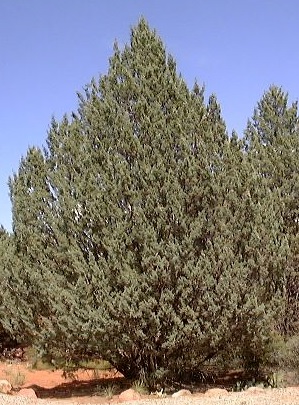 Coniferous Trees for the Verde Valley - October 15, 2014 Jeff Schalau, Agent, Agriculture & Natural Resources University of Arizona Cooperative Extension, Yavapai County Coniferous trees are resinous evergreens that bear their seeds in cones rather than true flowers. A conifer is also called a “gymnosperm” meaning naked seed. Examples are pine, fir, juniper, cedar, cypress, larch, and tamarack. Several conifers are suitable for planting in the Verde Valley area and fall is the best season to plant them. They can be planted as specimen trees for accent/interest or used as a privacy screen or windbreak. Remember that some of these trees are very large and may be unsuitable for small residential settings. However, many compact and pendulous cultivars are available and better suited to small spaces. Remember to irrigate conifers during dry winter periods as they still require water to conduct photosynthesis. Conifers are also very resinous which also makes them highly flammable and should not be planted close to your home or other flammable structures. Additional resources are available below. Arizona Cypress (Cupressus arizonica) is the only native cypress in the southwest. It is a large tree (40 ft tall/25 ft wide) with gray-green, scale-like foliage and will require irrigation during dry periods to avoid cypress bark beetle damage. The variety 'Glabra' has smooth, red bark that exfoliates every year. ‘Blue Ice’ is a smaller, conical cultivar but will still become large given time. Elderica Pine (Pinus elderica) can grow to 40 ft tall/20 ft wide if grown in a protected area or a dense stand. It is an excellent pine for Cottonwood, Camp Verde, and other areas of the Verde Valley that do not have extensive native oak populations. In the oak areas (such as Sedona), the Comandra plant acts as an alternate host for Comandra Blister Rust which can infect and eventually kill Elderica pine trees. It is also sold as Quetta pine, Goldwater pine, and Mondell pine. Japanese Black Pine (Pinus thunbergiana) has a spreading habit (20 ft tall/20 ft wide) in our climate and requires regular irrigation during the dry season. One of the few conifers that tolerates pruning and is suitable for planting in irrigated landscapes. Pinyon Pine (Pinus edulis or P. monophylla) is a well-adapted pine for the entire Verde Valley area. Both are very slow growing to 20 ft tall/15 ft wide. The seeds (pinyon nuts) are delicious if you can get them before the rodents and birds. Deodar Cedar (Cedrus deodara) is a large (80 ft high/40 ft wide), fast growing tree. In fact, it may be too large for many residential landscapes. Short, silvery-green needles are 1 ½ inches long and occur in rosettes. Graceful, pest resistant, and drought tolerant once established. They are widely planted in the Verde Valley and are distinguishable at a distance by their droopy tops. Atlas Cedar (Cedrus atlantica) is a smaller, more upright version of the Deodar cedar, but can grow to 50 ft high/30 ft wide. It is also drought tolerant and pest resistant. There are cultivars of Cedrus which include dwarf, pendulous, and horizontal growth habits. Blue Spruce (Picea pungens) can grow to 80 ft high/30 ft wide, but few specimens have been planted long enough to reach this size in the Verde Valley. Blue-gray needles are sharp and about 1 inch long. The blue color is due to a waxy coating on the leaves. Spruces are susceptible to spider mites. I suspect that the Verde Valley is on the edge of their suitable planting range because I have seen several die for no apparent reason. Junipers (Juniperus spp.) are available in many cultivated varieties which can be difficult to distinguish. Juniper trees rarely grow taller than 30 feet and 30 feet wide. Like cypress, they have scale-like leaves. They tend to be very drought tolerant and come in a range of colors and growth forms. Hollywood juniper (J. chinensis ‘Torulosa’) is a small landscape tree with an interesting, twisted growth form. Eastern red cedar (J. virginiana) is an upright tree and was widely planted in the past, but not as popular today. Native species include one-seed juniper (J. monosperma), Utah juniper (J. osteosperma), redberry juniper (J. coahuilensis), and alligator juniper (J. deppeana). Native junipers are sometimes available from local native plant growers. Leyland Cypress (Cupressocyparis leylandii) is a hybrid between Alaska yellow cedar and Monterey cypress. Leyland cypress is no longer recommended because it is very susceptible Seiridium Canker: a fungal disease that eventually kills the tree. Follow the Backyard Gardener on Twitter – use the link on the BYG website. If you have other gardening questions, call the Master Gardener help line in the Camp Verde office at 928-554-8999 Ext. 3 or e-mail us at verdevalleymg@gmail.com and be sure to include your name, address and phone number. Find past Backyard Gardener columns or provide feedback at the Backyard Gardener web site: http://cals.arizona.edu/yavapai/anr/hort/byg/. Additional Resources Arizona Cypress Backyard Gardener, September 11, 2013 ag.arizona.edu/yavapai/anr/hort/byg/archive/azcypress2013.html Cedars of Lebanon and Beyond Backyard Gardener, October 10, 2007 ag.arizona.edu/yavapai/anr/hort/byg/archive/cedarsoflebanon.html Comandra Blister Rust Backyard Gardener, December 17, 2003 ag.arizona.edu/yavapai/anr/hort/byg/archive/comandrablisterrust2003.html Seiridium Canker of Cypress Trees in Arizona University of Arizona Cooperative Extension Fact Sheet AZ1557 extension.arizona.edu/sites/extension.arizona.edu/files/pubs/az1557.pdf |